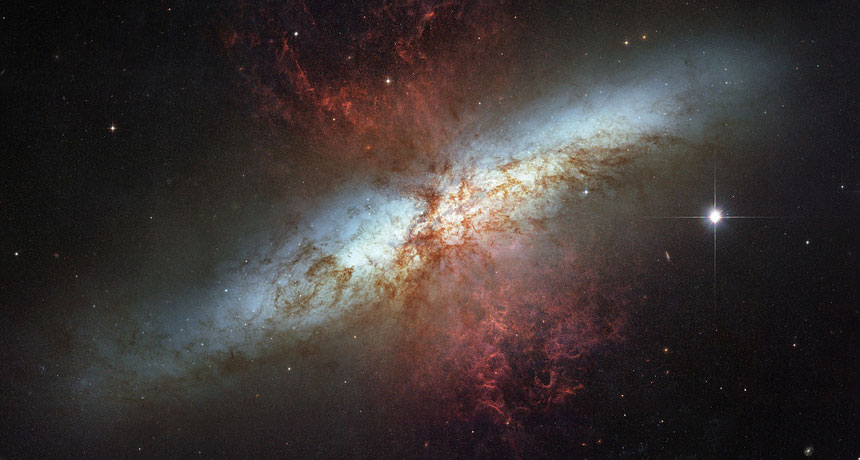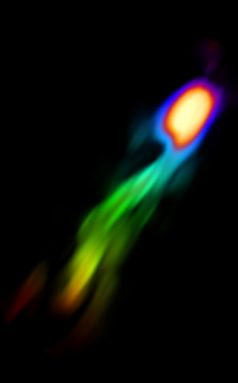Light robs galaxy of star-making gas
Light from newborn stars may prevent future generations from forming

The light from a burst of newly formed stars blows clouds of hydrogen gas (highlighted in red) out of galaxy M82. The Hubble Space Telescope captured this image.
NASA, ESA, HUBBLE HERITAGE TEAM (STSCI/AURA), J. GALLAGHER (UNIVERSITY OF WISCONSIN), M. MOUNTAIN (STSCI) AND P. PUXLEY (NSF)
Newborn stars may be starving their parent galaxy of the ingredients to produce more offspring.
The affected galaxy has a name that is rather hard to remember: SDSS J0905+57. Astronomers have just measured starlight from its fledgling stars. And they seem to be pushing out enough hydrogen to form billions more stars. The observations should help astronomers understand more about how and why star formation begins to shut down in a galaxy.
Details appear in a report published December 4 in Nature.

Stars form when gravity causes clouds of dust and gas to collapse into tight masses. Most of that gas is hydrogen. Hydrogen can be difficult to observe. So astronomers looked for it indirectly. They measured levels of a second gas — carbon monoxide. Why that gas? The proportion of carbon monoxide in a galaxy is usually closely related to how much hydrogen is present.
Using these data, the team concluded that huge quantities of hydrogen gas must be streaming out of the galaxy. That galaxy sits about 8 billion light-years away in the constellation Ursa Major (or the Great Bear).
This galaxy is churning out new stars roughly 100 times as fast as is our galaxy, the Milky Way.
Astronomer James Geach works at the University of Hertfordshire in England. He and his colleagues found that the intense light from all those newborn stars in SDSS J0905+57 provides enough energy to expel much of the surrounding hydrogen gas.
At the current rate of hydrogen loss, that galaxy could run out of stellar ingredients in just 10 million years. After that, it could become a galactic retirement home filled with aging stars.
Astronomers have debated whether starlight, stellar explosions or super-massive black holes force gas out of galaxies. All three probably have roles to play. However, the new observations show that light from newborn stars alone can be enough to do the job.
Power Words
astronomy The area of science that deals with celestial objects, space and the physical universe as a whole. People who work in this field are called astronomers.
black hole A region of space having a gravitational field so intense that no matter nor radiation (including light) can escape.
carbon monoxide A toxic gas whose molecules include one carbon atom and one oxygen atom. (The “mono” in “monoxide” is a prefix from Greek that means “one”.) One common source: fossil-fuel burning.
constellation Patterns formed by prominent stars that lie close to each other in the night sky. Modern astronomers divide the sky into 88 constellations, 12 of which (known as the zodiac) lie along the sun’s path through the sky over the course of a year. Cancri, the original Greek name for the constellation Cancer, is one of those 12 zodiac constellations.
galaxy A massive group of stars bound together by gravity. Galaxies, which each typically include between 10 million and 100 trillion stars, also include clouds of gas, dust and the remnants of exploded stars.
gravity The force that attracts anything with mass, or bulk, toward any other thing with mass. The more mass that something has, the greater its gravity.
hydrogen The lightest element in the universe. As a gas, it is colorless, odorless and highly flammable. It’s an integral part of many fuels, fats and chemicals that make up living tissues.
light-year The distance light travels in a year, about 9.48 trillion kilometers (almost 6 trillion miles). To get some idea of this length, imagine a rope long enough to wrap around the Earth. It would be a little over 40,000 kilometers (24,900 miles) long. Lay it out straight. Now lay another 236 million more that are the same length, end-to-end, right after the first. The total distance they now span would equal one light-year.
mass A number that shows how much an object resists speeding up and slowing down — basically a measure of how much matter that object is made from. Or the term can refer to anything containing mass.
Milky Way The galaxy in which Earth’s solar system resides.
star Thebasic building block from which galaxies are made. Stars develop when gravity compacts clouds of gas. When they become dense enough to sustain nuclear-fusion reactions, stars will emit light and sometimes other forms of electromagnetic radiation. The sun is our closest star.
stellar An adjective that means of or relating to stars.
supernova (plural: supernovae or supernovas) A massive star that suddenly increases greatly in brightness because of a catastrophic explosion that ejects most of its mass.







